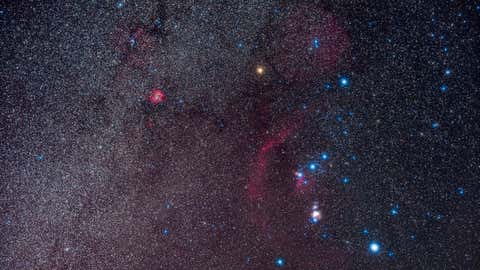

- Astronomers said the eclipse would last less than 15 seconds.
- Weather in the eclipse’s path in South Florida and the Florida Keys was iffy ahead of the event.
An asteroid named Leona and a giant star named Betelgeuse were poised to meet in the night sky Monday in a very brief, very rare type of eclipse.
“It’s a big event because Betelgeuse is a very bright and easy-to-find star,” John Gianforte, director of the University of New Hampshire Observatory, told us in an interview Saturday.
More about Leona, Betelgeuse and the eclipse:
Leona is a small asteroid by astronomical standards, while Betelgeuse is 15 times more massive than the sun. It’s also one of the most well-known stars in the night sky, located in the constellation Orion.
“It’s the brightest constellation out of all the 88 constellations,” Gianforte said. “Plus, Orion has this three-in-a-row pattern that goes across his belt. A lot of people can recognize this and see that in the sky and Betelgeuse is above, higher up in the sky by a little bit, than the belt of Orion.”
Betelgeuse also has a reddish glow, making it very obvious to the naked eye.
Gianforte says that while an asteroid crossing over a star is a type of eclipse, astronomers classify it as occultation, which is when a foreground object covers up a star.
In this case, that was expected to cause Betelgeuse’s light to appear to very quickly fade and then brighten again – kind of like a super fast, mini version of a solar eclipse.
“And instead of being in the shadow of the moon like what happens during a solar eclipse, people in the path of this event will be in the shadow of the asteroid,” Gianforte said.

A portrait of Orion and the northern winter Milky Way on a February night in 2020.
(Alan Dyer/VW PICS/Universal Images Group via Getty Images)
The path of the Betelgeuse eclipse:
That path followed a very narrow band from parts of Europe into Mexico and the southern tip of Florida, running roughly from Fort Lauderdale across to Everglades City and down into the Florida Keys.
Astronomers said the eclipse would happen roughly between 8:23 and 8:26 p.m. EST and last less than 15 seconds. Viewers could use this interactive map to get a more specific idea of when and where it would be visible.
Weather was iffy ahead of the event, though.
“A cold front has pushed off the coast of South Florida, and while normally we see clear skies behind them, that won’t be the case this evening for most,” weather.com senior meteorologist Chris Dolce said Monday morning. “Mostly cloudy to cloudy skies are expected since the jet stream will be transporting cloud cover over the southern part of the state.”
Anyone not in the path, or with cloudy skies, could try to catch the eclipse on a livestream from the Virtual Telescope Project starting at about 8 p.m. EST.
What else makes this so interesting:
Astronomers planned to use the event to study both Leona and Betelgeuse. The star in particular intrigues scientists.
“We’re pretty sure based on observations and our knowledge of how stars evolve, in the next million years, Betelgeuse will definitely explode as a supernova,” Gianforte said. “I know that’s a long time for people, but it’s not a long time for stars.”
In fact, there’s a chance it may have already happened. Betelgeuse is about 600 to 700 light years from Earth, which means it takes light from the star that long to reach us.
MORE ON WEATHER.COM
–Photo Captures Boy’s Joy Of Seeing Starship Launch
-Harvard Professor Skips Retirement For Chance To Help Save The Planet
-How Queen’s Brian May Helped NASA’s Bennu Mission
Weather.com reporter Jan Childs covers breaking news and features related to weather, space, climate change, the environment and everything in between.
The Weather Company’s primary journalistic mission is to report on breaking weather news, the environment and the importance of science to our lives. This story does not necessarily represent the position of our parent company, IBM.

